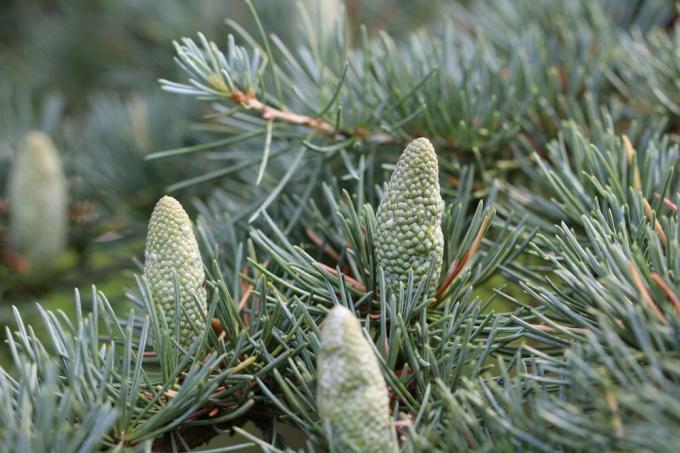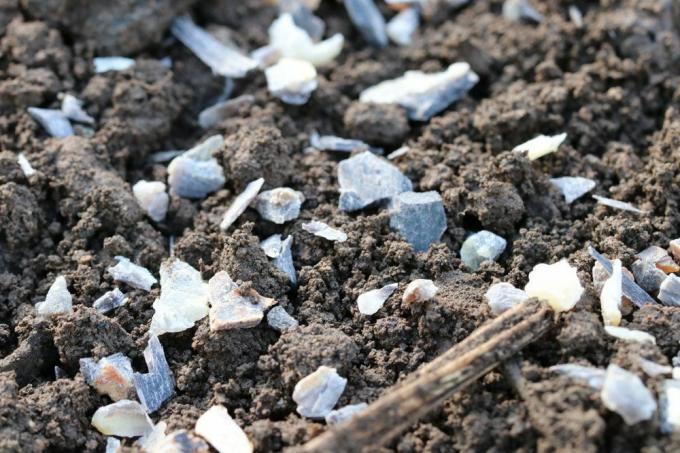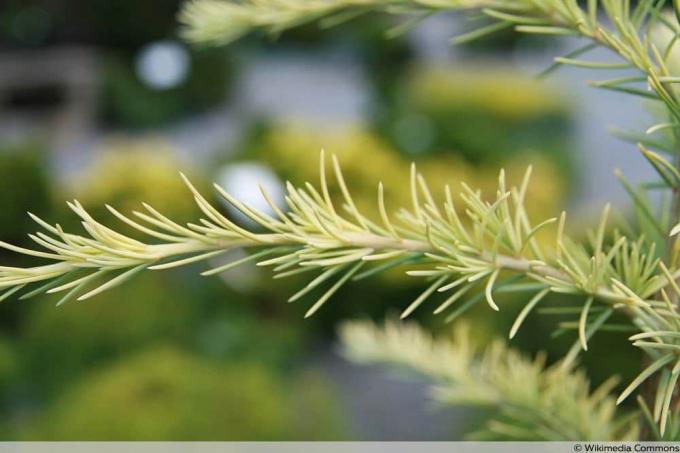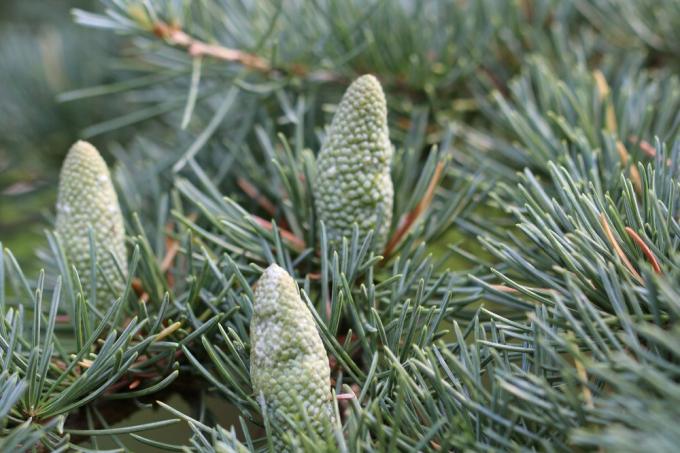
table of contents
- Characteristics
- Care instructions
- Heyday
- Soil condition & location
- Fertilizing and watering
- Diseases & pests
- Bucket cultivation
- plants
- Plant neighbors
- Cut
- sorts
- Overwinter
- Multiply
Profile and care information open +conclude -
- Flower color
- yellow, inconspicuous, green
- Location
- Sunny, full sun
- Heyday
- September October
- Growth habit
- upright
- height
- up to 50 meters high (freely growing)
- Soil type
- sandy, loamy
- Soil moisture
- moderately dry, fresh
- PH value
- neutral, weakly alkaline, weakly acidic
- Limescale tolerance
- Calcium tolerant
- humus
- rich in humus
- Plant families
- Pine family, Pinaceae
- Plant species
- Potted plants, Conifers
- Garden style
- Park, pot garden
As the name of the Himalayan cedar suggests, it originally comes from India, Pakistan and the Hindu Kush. Here is Cedrus deodara widespread. The cedar species, which belongs to the pine family, is also becoming increasingly popular in the local latitudes, which is probably also due to its good winter hardiness. In addition, there are different varieties in the local trade that can be cultivated in the gardens and even in the tub. The care of the Himalayan cedar is quite easy and the tree is therefore also well suited for hobby gardeners with little time.
Characteristics
- botanical name Cedrus deodara
- belongs to the family of pine trees (Pinaceae)
- freely growing up to 50 meters high
- spreading growth in crown
- needles can be dropped in winter
- has blue needles
- small varieties can also be cultivated in pots
- lime tolerant
- hardy
- forms cones
Care instructions

If the cedar species is up to 50 meters high in your natural environment, there are different varieties that are also suitable for the local gardens are suitable and can even be cultivated in a tub on the balcony or terrace. But it always looks nice when the Himalayan cedar is planted as a solitary in the middle of a meadow. The cedars also often decorate large parks and urban areas here, thanks to the simple maintenance. When cultivating, however, it should be borne in mind that the Himalayan cedars grow very broad and expansive. The following is also important in the instructions for care:
- Do not let it dry out even in winter
- Tree can be damaged by drought
- Water on frost-free days
- tree is slow to recover from the damage
- fertilize regularly according to the instructions
- Cut is not necessary
Tip: When deciding on a variety of Cedrus deodara, there is little effort to care for. So this is the tree for you too if you're short on time.
Heyday
In the period from September to October, Cedrus deodara develops its small, mostly inconspicuous flowers. The females are green-yellowish and about two centimeters tall. The male flowers that also grow on the same tree are of the same color but slightly larger. The real ornament here, however, are the egg-shaped cones that develop from the flowers. They become about 13 centimeters long and change their color from blue to green-reddish over time. When they are fully ripe, they turn a dark brown color.
Soil condition & location
The Himalayan cedar is a shallow root and, despite its size, cannot anchor itself so well in the ground. Therefore, when choosing the location, it is important to remember that the tree could fall over in a strong storm. Therefore, a sheltered place that is not in direct proximity to a building is the right choice. The chosen location should also be in full sun and warm. This also applies to the varieties sold in local latitudes that are not quite as big. The soil should be as follows:
- deep and slightly dry
- Avoid waterlogging at all costs
- high nutritional content
- Enrich with compost before planting
- Lime is tolerated
- slightly acidic, sandy loam soil is ideal
Tip: Since the high varieties of the Himalayan cedar are usually not cultivated in the local latitudes, a suitable location is quite easy to find. Because the tree unfolds its decorative effect especially as a solitaire on a meadow or in a bucket in a stone or front garden.
Fertilizing and watering

Even if the soil does not have to be moist, the Himalayan cedar should be poured in during dry periods in summer as well as in winter. Because the tree does not recover so quickly from damage caused by drought and remains unsightly for a long time. Therefore, the cedar has to be watered in good time. It is recommended to water with collected rainwater. However, since the tree is lime-tolerant, tap water can also be used. However, waterlogging should also be avoided. Pay attention to the following when watering and fertilizing:
- water in the evening or early morning
- only on the roots
- Container plants need more fertilizer
- is washed out faster by the pouring process
- fertilize once a year in spring
- Fold in the compost
- mulch around roots
- offers year-round nutrient supply
Diseases & pests
Diseases and Pests are not yet known from Cedrus deodara, because the tree is very robust. Nevertheless, there are maintenance mistakes that can damage the cedar. This includes, on the one hand, dehydration in dry periods. On the other hand, care should always be taken to ensure that the flat and long-growing roots do not come into contact with road salt in winter.
Bucket cultivation
The small varieties of Cedrus deodara can also be grown in a tub. Then you will find a place on the balcony or terrace as well as in a sunny house entrance. It should be noted that the pot is rather wide than high so that the flat roots have space on all sides. When planting in the tub, the following instructions should be followed:
- Use potting soil for conifers
- Create drainage in the bucket
- Gravel or pottery shards over drain hole
- plant fleece above
- fill in part of the earth
- Insert cedar
- Fill in the rest of the soil
- water well
Tip: You can choose small varieties for cultivation in pots, some of which are only up to 40 centimeters high. But even small trees that are between one and two meters high can be cultivated in a tub, depending on the suitable location.
plants

The Himalayan cedar should ideally be planted in spring so that it can take root well by the next winter. In order to ensure a firm stand, a support post should be used for the first few years when planting. When planting, you should then proceed as follows:
- Dig the planting hole
- twice as deep and wide as the root ball
- put drainage on the floor
- Put stones in the planting hole
- Mix soil with compost
- Insert tree
- make sure you stand straight
- Put the support post directly into the hole
- Fill in prepared soil
After the earth around the tree has been trodden a little, it should be watered well. Then horn shavings and bark mulch can be distributed. The horn shavings are used for fertilization, the mulch prevents the soil from drying out and also releases nutrients into the soil on a regular basis.
Note: Do not be surprised if your cedar sheds its needles after planting, this often happens, even after a long, harsh winter. This is a completely natural characteristic of the tree. The needles grow back after a short time.
Plant neighbors
As a shallow root, the Himalayan cedar needs a lot of space around the trunk. In addition, the large varieties cast a lot of shade. Therefore, plants in close proximity to the tree are not recommended, as they would be displaced by the roots here. However, if the cedar was cultivated in a tub, all plants that are well tolerated by shade can be placed around the cedar in their own tub.
Cut
As a rule, the Himalayan cedar does not need a cut. Only when individual branches are dry or damaged should they be removed. The best time for this is early spring and early autumn. To make the crown more beautiful, the tree can also be pruned. The procedure is as follows:
- Remove branches directly from the trunk
- starting from the ground up to half of the trunk
- cut as close to the trunk as possible
- but do not injure the trunk
- only use sharp tools
- Disinfect before cutting
- otherwise bacteria, viruses or fungi could get into the wound
sorts

Source: Photo by David J. Rod, Cedrus deodara Aurea 1zz, Edited by Gartenlexikon.de (MKr), CC BY-SA 4.0
The wood of the Himalayan cedar was already in great demand in ancient times. Because the trees are durable and robust, and so is the wood. In addition, it exudes a pleasant scent that only slowly fades after whipping and recycling. Small varieties are particularly interesting for the local latitudes, because they can be cultivated in the garden on a green area or in a tub. The following hybrids, among others, were bred:
- "Aurea"
- three to five meters, conical growing
- "Blue Dwarf"
- spherical dwarf shape
- "Ice rain"
- growing upright
- "Klondyke"
- columnar and upright growing
- "Silver Mist"
- conical small cedar
Tip: The instructions for care apply to all types of Himalayan cedar, irrespective of whether they are tall and spreading or rather small and cultivated in a tub.
Overwinter
The Himalayan cedar is hardy in the local latitudes and usually does not need any winter protection. However, the following should be noted in winter:
- Cover young trees with fleece
- to be recommended especially in cold climates
- Protect potted plants
- Wrap the bucket with brushwood mats
- place on wooden or styrofoam plate
- Slide it into a protected corner
Tip: If you do not mulch all year round, you should sprinkle bark mulch around the roots in winter. If you mulch all year round, you should always make sure that it does not rot and mold and therefore replace it occasionally.
Multiply

Although there is the possibility of propagation between sowing, cutting or grafting, the Himalayan cedar is very difficult to propagate yourself. The seeds you have collected yourself are usually not suitable for your own sowing, and propagation often does not succeed even with purchased seeds. This year's shoots should be used for cuttings and grafting. But here, too, the propagation is usually not promising, the shoots obtained die before they take root or grow in the trunk. Therefore, it should be avoided to multiply and a new, ready-made small tree should be purchased in stores.

